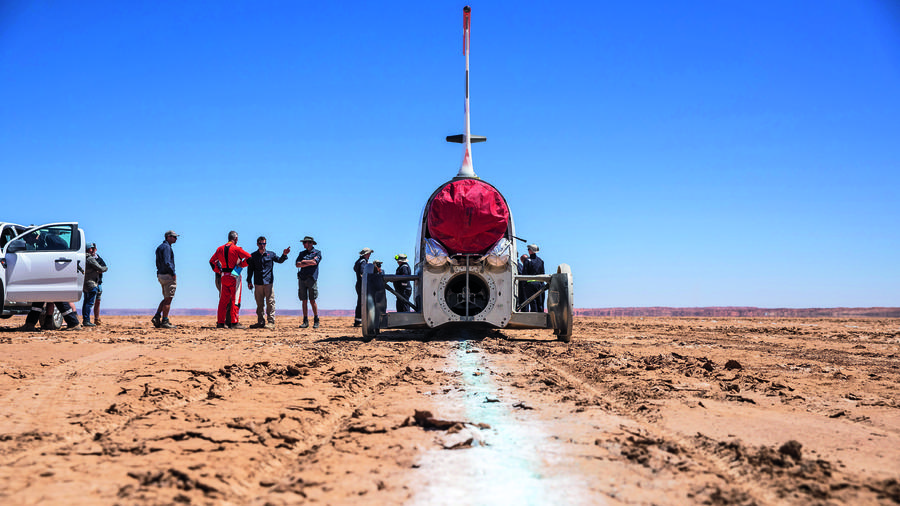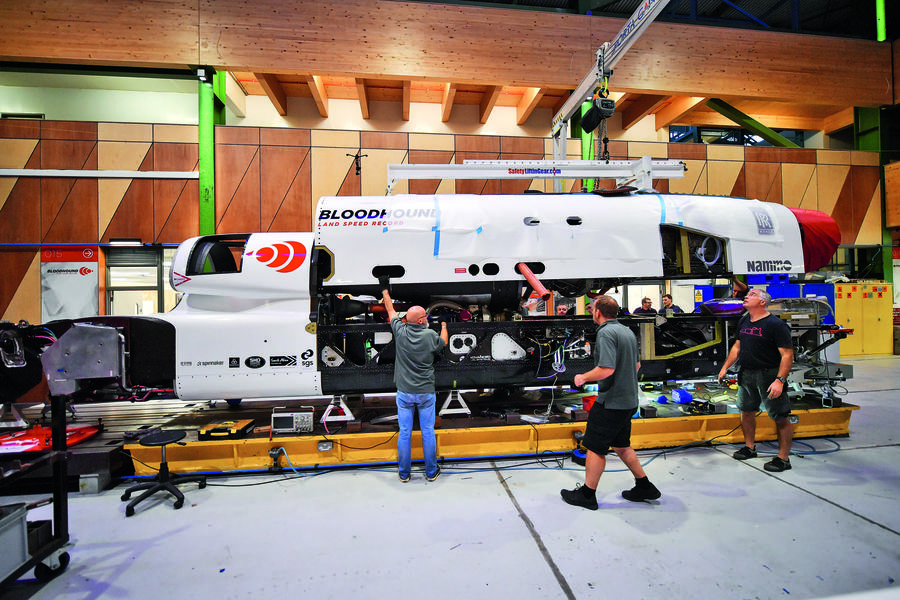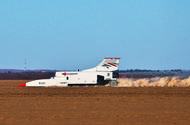Bloodhound ran at 628mph in South Africa in 2019 tests
Newly revived jet-car project seeks replacement for Andy Green, plus funds to break the land speed record
Bloodhound, the British jet-rocket car bidding to push the world land speed record beyond 800mph, is on the hunt for a well-heeled new driver to help fulfil its creators’ long-held dream.
Bloodhound’s only driver so far, and the existing speed record holder, Wing Commander Andy Green, is standing aside in the interests of raising the funds the project needs for its next phase. But he’ll continue to be a vital part of the team as the new driver’s mentor and coach.
Green, a former fast jet pilot, believes the new driver will ideally be someone with pilot level skills, or a top end racing driver. He also confirms that he’ll be on hand to drive in case the new recruit decides that 500mph is enough, but is willing to fund the next record run, a bid to beat 800mph.
While the search goes on, the project is being reconfigured to deliver its world-beating performance in a new, zero-emissions guise – and become a prospective pioneer in the development of synthetic fuels that will power the low-emissions intercontinental aircraft of tomorrow.
Bloodhound’s owner, Ian Warhurst, estimates that the project will need around £12 million to beat 800mph, its primary objective. It began life with a modest £600,000 government grant 15 years ago.
Backers have been displaying a full-size replica of the car at seven venues in England – beginning with the British Motor Museum at Gaydon – in a bid to “attract passionate and skilled individuals who are ready to push the boundaries of speed and aspire to become part of history by driving the fastest car on Earth”.
The “once-in-a-lifetime opportunity” will take place on a specially prepared track in South Africa.

The project, born out of a conversation 20 years ago between Green and his predecessor-cum-project organiser Richard Noble, has passed through several sets of hands, encountering what looked like terminal financial problems and at one stage came within a day of being cut up for scrap before being rescued by Warhurst.
Most recently, the project was knocked off course by a lack of funds and the effects of the Covid pandemic. It has been in abeyance ever since, stored in Coventry’s Transport Museum with two earlier Thrust record breakers.
Bloodhound CEO Stuart Edmondson said: “As we enter a new chapter of the Bloodhound LSR project, I’m excited about the opportunity and challenges that lie ahead and confident that this will enable us to return to South Africa and set a new record.
“With a new driver, along with my aim of not using fossil fuels to set a new FIA Outright World Land Speed Record, the project promises to be exciting, engaging and relevant at so many levels.”
Bloodhound’s zero-emissions push
Powered by conventional jet fuel, Bloodhound ran successfully in 2019 at speeds of up to 628mph (the current record, achieved by the same team with the Thrust SCC car in 1997, stands at 763.035mph) on a specially prepared track at Hakskeen Pan in the north of South Africa.
However, the arrival of new CEO Edmondson, with a radical plan to run the car’s Rolls-Royce-made Eurofighter Typhoon engines on specially formulated zero-emissions synthetic fuel, has transformed the project’s relevance and appeal, especially since the car’s previous high-capacity ICE-powered fuel pump has also been ditched in favour of an EV pump and a lightweight battery.
Edmondson, a project manager and professional fast-jet engineer who joined Bloodhound in 2014 at the end of a 19-year Royal Air Force career, believes Bloodhound can contribute invaluable data towards the “rapidly accelerating and very exciting” development of tomorrow’s jet fuels.
“Our Rolls-Royce EJ200 engine powers something like 1000 jet fighters in use across the world, and they’re likely to be around for years to come,” he said. “It helps a lot that our tests are fundamentally safe, because our car is always on the ground if something goes wrong.”
Edmondson admits that as “a fire-breathing machine of the old school”, Bloodhound had lost its relevance, but as a user of synthetic fuels, it has become important all over again.
He also hopes that this change will renew the project’s appeal to young people. Bloodhound has always set great store by its contact with students, hoping it will encourage them to follow STEM subjects.

Apart from its Rolls-Royce jet, the other major component of Bloodhound’s power pack is its Norwegian-made Nammo rocket motor, which provides the immense power needed to take Bloodhound’s top speed from around 650mph to beyond 800mph.
That motor has always been as green as they get, Edmondson pointed out. It’s fuelled by hydrogen peroxide, whose only emissions are steam and oxygen.
Given that it’s already 14 years since the Bloodhound project began and that there have been many successes and reverses along the way, Edmondson is reluctant to put a binding date on the car’s reappearance in action.
But the team, the car, the track and the South African authorities are all ready to go again, he said, so with the right funding, the car could easily be ready to run by 2024.
Source: Autocar
